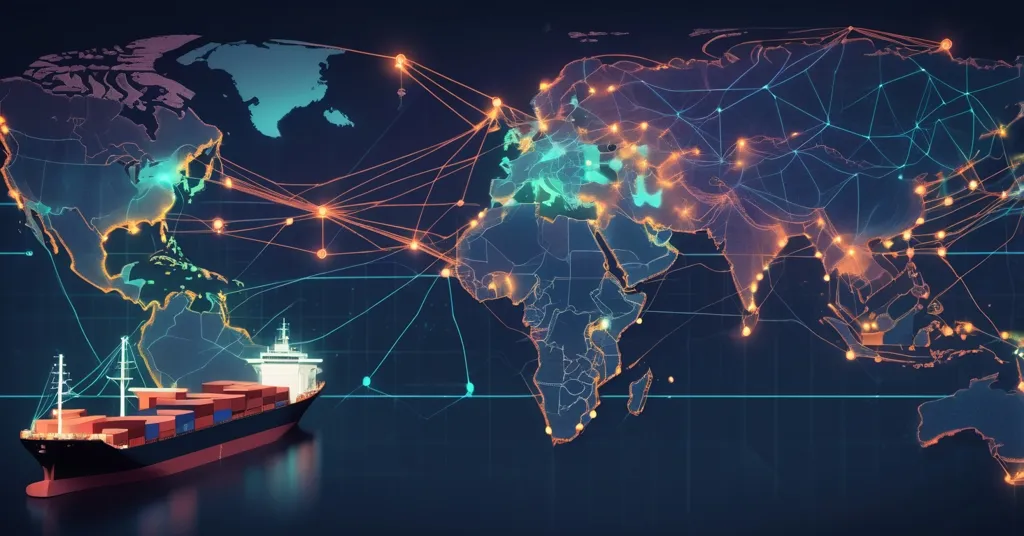Trump’s 40% Tariff on Rerouted Goods Sparks Trade War and Blockchain Potential

Trump’s 40% Tariff on Rerouted Goods: Trade War Reloaded with a Crypto Twist
Donald Trump has dropped a bombshell on global trade, announcing a 40% tariff on goods rerouted through other countries to sidestep existing U.S. tariffs, with an unspoken but obvious focus on China. This White House policy, part of a broader duty range of 10% to 41%, is shaking up markets from Southeast Asia to North America, and it might just spotlight blockchain as a disruptor in the murky world of international trade.
- Policy Breakdown: 40% tariff on transshipped goods to close loopholes, within a 10%-41% global duty framework.
- Global Uncertainty: Undefined “transshipment” rules leave exporters scrambling for clarity.
- Crypto Connection: Could blockchain’s transparency solve trade opacity, aligning with Bitcoin’s decentralized ethos?
The Tariff Bombshell: Targeting Trade Shell Games
Let’s cut through the noise: Trump’s latest move is a direct attack on a sneaky trade tactic known as transshipment. For those new to the term, transshipment is when goods—often from a country like China facing heavy U.S. tariffs—are shipped through a middleman nation, say Vietnam or Thailand, with just enough processing or repackaging to claim a different origin. It’s a shell game on a global scale, designed to dodge duties. The White House, unveiling this policy on transshipment tariffs, aims to slam the door shut with a 40% tariff on such rerouted goods, nested within a wider set of duties hitting imports at rates from 10% to 41%. Nations not explicitly mentioned in the tariff list? They get a default 10% slap for good measure.
Trump is doubling down on urgency, shouting from the rooftops about a firm deadline.
“THE AUGUST FIRST DEADLINE IS THE AUGUST FIRST DEADLINE — IT STANDS STRONG, AND WILL NOT BE EXTENDED. A BIG DAY FOR AMERICA!!!”
Yet, confusion reigns—while Trump pushes August 1, a White House official hinted at August 7 for reciprocal tariffs, and fact sheets point to 2025 dates for related measures. This mixed messaging leaves businesses in a tailspin, unsure when or how to adapt. Navigating these tariffs feels like playing whack-a-mole: every time the U.S. swings, exporters pop up with a new workaround.
Southeast Asia Caught in the Crossfire
Southeast Asian countries—Vietnam, Thailand, Cambodia, Indonesia, and Malaysia—are sweating bullets over this. Since the U.S.-China trade war kicked off in 2018, these nations have become major exporters to the U.S., often using Chinese components in their goods. Take Vietnam: U.S. imports from there have grown at a 15.7% compound annual rate from 2018 to 2024, fueled by supply chains shifting out of China. But with Chinese parts still in the mix, the big question is whether their exports will get hit with the 40% tariff. The rules of origin—think of them as a recipe determining if a product is “made in Thailand” based on where most of its ingredients come from—remain unclear. Thailand, for instance, requires over 40% local content to classify goods as Thai-made, but there’s no U.S. agreement on this standard. Chantawit Tantasith, Thailand’s Deputy Minister of Commerce, captured the frustration:
“We must await further clarification from the US regarding the negotiation process and rules of origin.”
For deeper insight, check this analysis of U.S. tariffs impacting Southeast Asian trade.
Let’s be clear: while China isn’t named outright in the announcement, it’s the giant in the shadows. This policy lands just weeks before a tariff truce with Beijing expires, ramping up pressure on already tense U.S.-China trade talks. Since 2018, Chinese firms have leaned on regional trade pacts like the Regional Comprehensive Economic Partnership (RCEP), effective since 2022, to slash barriers across Asia. This makes distinguishing real manufacturing from mere transshipment a nightmare. Goods with significant foreign inputs can still claim local origin under such agreements, creating legal gray areas. A senior U.S. official admitted the definition of transshipment won’t be finalized until “the coming weeks,” despite earlier promises of clarity by August. Good luck planning around that vagueness. For a broader look at how transshipment impacts global trade, there are some useful discussions online.
Expert Warnings: A Flawed Strategy?
Trade analysts aren’t buying this as a game-changer. Leah Fahy, Chief Economist at Capital Economics, pointed out a gaping hole:
“Even if outright rerouting is reduced, trade diversion will continue to dampen the impact of US tariffs on China’s aggregate export performance.”
Translation? China’s already adapted, funneling goods through “friendly” nations or other markets like Europe—think of it as rerouting trade flows to dodge the U.S. punch. Stephen Olson, a former U.S. trade negotiator at ISEAS-Yusof Ishak Institute in Singapore, warned of bigger fallout:
“China will correctly perceive the transshipment provisions as directed against its interests. And it will inevitably spill over into its ongoing trade negotiations with the US.”
With China having trade-war-proofed its economy through diversified supply chains, as some reports suggest, this tariff might be a day late and a dollar short. For more on this, see this expert take on U.S.-China trade dynamics.
Beyond China, there’s another wrinkle: the White House tied part of its tariff rhetoric to Canada’s failure to curb fentanyl trafficking across the northern border, with seizures this year outpacing the last three combined. While not directly tied to Southeast Asia, it shows Trump’s “America First” agenda isn’t just about economics—it’s a multi-front battle on trade and security. Could this broader stance spill over into other areas, like tightening cross-border financial flows or even crypto transactions? It’s not a stretch to think so. For historical context, you can explore tariff policies under Trump’s administration.
Blockchain: A Dark Horse in the Trade War?
Now, let’s zoom in on a perspective that hits home for our Bitcoin and crypto crowd. At its core, the transshipment mess boils down to opacity—supply chains are a black box, with dodgy paperwork hiding where goods really come from. Enter blockchain, the tech behind Bitcoin, which acts like a tamper-proof digital diary. It records data in a way that can’t be altered, offering a potential fix for tracking a product’s journey from factory to shelf. Imagine every component’s origin logged on an immutable ledger, making it impossible to fake a “made in Vietnam” label for Chinese goods. Projects like VeChain and IBM’s Food Trust are already tackling supply chain transparency—Walmart uses blockchain to trace food products in seconds. A policy like Trump’s could turbocharge adoption if governments demand verifiable data to enforce tariffs. Learn more about blockchain’s role in trade transparency.
This isn’t just tech geekery; it ties directly to Bitcoin’s ethos of cutting through centralized nonsense. Just as Bitcoin challenges financial gatekeepers, blockchain could disrupt shady trade practices by decentralizing trust. If supply chain data lived on a public ledger, regulators wouldn’t need to rely on corruptible middlemen or forged documents. Hell, it’s a middle finger to the bureaucratic quagmire of global trade. But as a nod to my Bitcoin maximalist leanings, I’ve got to ask: are altcoin-based solutions like VeChain as secure as Bitcoin’s battle-tested network? Could a parallel trade system, inspired by Bitcoin’s borderless nature, emerge outside government control altogether?
The Flip Side: Challenges and Risks for Crypto
Before we get carried away with optimism, let’s play devil’s advocate. Blockchain isn’t a magic wand—rolling it out globally for trade compliance is a logistical beast. Storing vast amounts of supply chain data on-chain can be costly and slow, especially on networks not built for scale. Privacy’s another sticking point: if every transaction is transparent, companies might balk at exposing sensitive business details. Regulators, too, might prefer centralized databases they can control over decentralized ledgers—governments like the U.S. aren’t exactly crypto cheerleaders. Could this push for transparency backfire, with authorities rejecting blockchain in favor of old-school systems?
Then there’s the hardware angle. China dominates manufacturing of crypto essentials, like ASIC miners for Bitcoin. If tariffs on Chinese tech—or rerouted components—drive up costs, American miners could feel the pinch, slowing network growth or pushing operations to pricier regions. Vietnam, a hub for crypto adoption, might see indirect boosts in local blockchain innovation as trade systems pivot, but escalated trade tensions could also tank regional economies, curbing investment in tech. And let’s not ignore the regulatory risk: Trump’s hardline “America First” stance, especially with fentanyl rhetoric in the mix, might lead to stricter crypto laws under the guise of national security. Bitcoin’s borderless nature dodges some of this, sure, but exchanges and miners tied to U.S. soil might not be so lucky. For a deeper dive into how trade wars impact crypto hardware costs, there’s plenty to consider.
Looking Ahead: Trade, Tech, and Decentralization
Trump’s 40% tariff is a bold swing at protecting U.S. interests, but it’s a messy one. Trade diversion could blunt its impact, geopolitical tensions with China are set to flare, and Southeast Asian nations are left dangling in uncertainty. For the crypto space, there’s a dual-edged sword: blockchain could emerge as a champion of transparency in global trade, proving decentralization’s real-world value, but trade wars might also squeeze crypto infrastructure through higher costs or tighter rules. One thing is certain—these tariffs are just the opening shot in a longer battle, and the fallout could ripple into markets even Bitcoin can’t fully escape. Could policies meant to shield American jobs paradoxically hurt U.S. miners reliant on Chinese hardware? That’s the kind of unintended consequence worth chewing on. Community perspectives on Trump’s tariff effects on trade wars offer additional food for thought.
Key Takeaways and Questions
- What’s the aim of Trump’s 40% tariff on rerouted goods?
It targets goods, primarily from China, dodging U.S. tariffs by passing through third-party countries, aiming to protect American manufacturing. - Why is there so much uncertainty around this policy?
The U.S. hasn’t defined “transshipment” or set clear rules of origin, leaving exporters and businesses unclear on who’ll be hit. - How are Southeast Asian nations affected?
Countries like Vietnam and Thailand, reliant on Chinese parts for U.S. exports, risk facing the 40% tariff, disrupting their trade flows. - Could blockchain offer a solution to trade opacity?
Yes, its immutable ledger could track goods’ origins transparently, as seen with projects like VeChain, potentially curbing fraudulent rerouting if scaled. - What risks do tariffs pose to the crypto sector?
Higher costs for Chinese-made hardware like Bitcoin miners, plus potential regulatory crackdowns tied to national security, could burden the industry.



